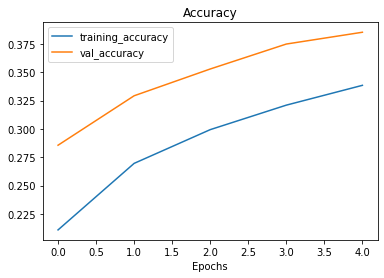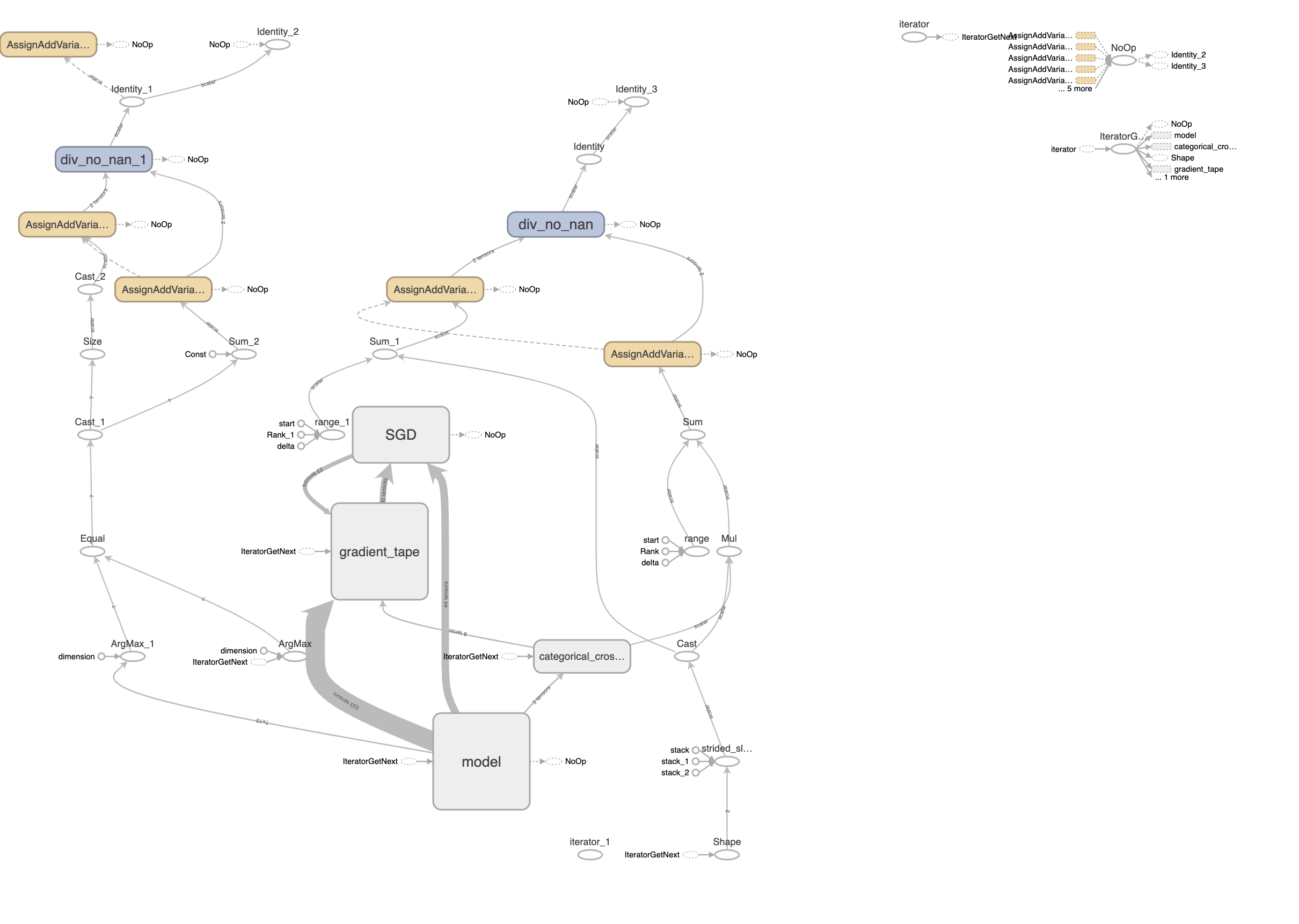使用TensorFlow进行图片分类¶
Info
作者:Vincent,发布于2022-05-23,阅读时间:约3分钟,微信公众号文章链接:
1 前言¶
本文将使用TensorFlow对多类别图片分类的任务进行讨论,主要内容包含图片数据的加载、数据增强、模型训练和迁移学习和TensorBoard的使用,所有的API均基于TensorFlow v2.8.0。以下代码在Google Colab里运行,因为Google提供了免费的GPU显著加快训练速度。
2 处理图片¶
加载包含目标有10类的原始图片数据。
import zipfile
import os
import matplotlib.pyplot as plt
import datetime
import tensorflow as tf
from tensorflow.keras.preprocessing.image import ImageDataGenerator
from tensorflow.python.ops.gen_array_ops import shape
from tensorflow.keras import layers
!wget https://storage.googleapis.com/ztm_tf_course/food_vision/10_food_classes_all_data.zip
# Unzip the downloaded file
zip_ref = zipfile.ZipFile("10_food_classes_all_data.zip", "r")
zip_ref.extractall()
zip_ref.close()
# 处理图片的函数
def load_and_process_image(file_name, img_shape=224):
"""
Read an image and process it, reshape it to (img_shape, img_shape, color_channels)
"""
# read the image
img = tf.io.read_file(file_name)
# decode the read file into a tensor
img = tf.image.decode_image(img)
# resize the image
img = tf.image.resize(img, size=[img_shape, img_shape])
# scale the image
img = img/255.
return img
# 显示文件
def list_files(startpath):
for root, dirs, files in os.walk(startpath):
level = root.replace(startpath, '').count(os.sep)
indent = ' ' * 4 * (level)
print('{}{}/'.format(indent, os.path.basename(root)))
subindent = ' ' * 4 * (level + 1)
for f in files:
print('{}{}'.format(subindent, f))
# Walk through 10_food_classes directory and list number of files
for dirpath, dirnames, filenames in os.walk("10_food_classes_all_data"):
print(f"There are {len(dirnames)} directories and {len(filenames)} images in '{dirpath}'.")
由输出可见,数据里有冰淇淋,牛排、披萨之类的图片。
There are 2 directories and 0 images in '10_food_classes_all_data'.
There are 10 directories and 0 images in '10_food_classes_all_data/test'.
There are 0 directories and 250 images in '10_food_classes_all_data/test/chicken_wings'.
There are 0 directories and 250 images in '10_food_classes_all_data/test/pizza'.
There are 0 directories and 250 images in '10_food_classes_all_data/test/grilled_salmon'.
There are 0 directories and 250 images in '10_food_classes_all_data/test/sushi'.
There are 0 directories and 250 images in '10_food_classes_all_data/test/fried_rice'.
There are 0 directories and 250 images in '10_food_classes_all_data/test/ice_cream'.
There are 0 directories and 250 images in '10_food_classes_all_data/test/chicken_curry'.
There are 0 directories and 250 images in '10_food_classes_all_data/test/hamburger'.
There are 0 directories and 250 images in '10_food_classes_all_data/test/ramen'.
There are 0 directories and 250 images in '10_food_classes_all_data/test/steak'.
There are 10 directories and 0 images in '10_food_classes_all_data/train'.
There are 0 directories and 750 images in '10_food_classes_all_data/train/chicken_wings'.
There are 0 directories and 750 images in '10_food_classes_all_data/train/pizza'.
There are 0 directories and 750 images in '10_food_classes_all_data/train/grilled_salmon'.
There are 0 directories and 750 images in '10_food_classes_all_data/train/sushi'.
There are 0 directories and 750 images in '10_food_classes_all_data/train/fried_rice'.
There are 0 directories and 750 images in '10_food_classes_all_data/train/ice_cream'.
There are 0 directories and 750 images in '10_food_classes_all_data/train/chicken_curry'.
There are 0 directories and 750 images in '10_food_classes_all_data/train/hamburger'.
There are 0 directories and 750 images in '10_food_classes_all_data/train/ramen'.
There are 0 directories and 750 images in '10_food_classes_all_data/train/steak'.
取出所有的标签:
class_names = os.listdir("10_food_classes_all_data/train/")
train_dir = "10_food_classes_all_data/train/"
test_dir = "10_food_classes_all_data/test/"
同时,使用TensorFlow的tensorflow.keras.preprocessing.image.ImageDataGenerator API对图片进行处理和增强,简而言之,该API能有效地根据文件目录自动为图片生成标签,并且按照设定的操作对图片进行增强。注意,数据增强只能用于训练集。
train_datagen_augmented = ImageDataGenerator(rescale=1/255.,
rotation_range=20, #旋转图片
shear_range=0.2, #剪切图片
zoom_range=0.2, #缩放图片
width_shift_range=0.2, #左右平移
height_shift_range=0.2, #上下平移
horizontal_flip=True) #左右翻转
train_datagen = ImageDataGenerator(rescale=1/255.)
test_datagen = ImageDataGenerator(rescale=1/255.)
# 生成数据集
train_data = train_datagen_augmented.flow_from_directory(train_dir,
target_size=(224,224),
batch_size=32,
shuffle=True)
test_data = test_datagen.flow_from_directory(test_dir,
target_size=(224,224),
batch_size=32
)
3 建模¶
3.1 基线模型¶
先做一个卷积神经网络作为基线模型:
# 绘制训练曲线
def plot_loss_curves(history):
"""
Returns separate loss curves for training and validation metrics.
"""
loss = history.history['loss']
val_loss = history.history['val_loss']
accuracy = history.history['accuracy']
val_accuracy = history.history['val_accuracy']
epochs = range(len(history.history['loss']))
# Plot loss
plt.plot(epochs, loss, label='training_loss')
plt.plot(epochs, val_loss, label='val_loss')
plt.title('Loss')
plt.xlabel('Epochs')
plt.legend()
# Plot accuracy
plt.figure()
plt.plot(epochs, accuracy, label='training_accuracy')
plt.plot(epochs, val_accuracy, label='val_accuracy')
plt.title('Accuracy')
plt.xlabel('Epochs')
plt.legend()
# 建模
tf.random.set_seed(42)
tf.keras.backend.clear_session()
cnn_model = tf.keras.models.Sequential([
layers.Conv2D(filters=10, kernel_size=(3,3), activation="relu",
input_shape=(224, 224, 3)),
layers.MaxPooling2D(pool_size=2),
layers.Conv2D(filters=10, kernel_size=(3,3), activation="relu"),
layers.MaxPooling2D(pool_size=2),
layers.Flatten(),
layers.Dropout(0.5),
layers.Dense(10, activation="softmax")
])
cnn_model.compile(loss=tf.keras.losses.CategoricalCrossentropy(),
optimizer=tf.keras.optimizers.Adam(),
steps_per_execution = 50,
metrics="accuracy")
def create_tensorboard_callback(dir_name, experiment_name):
log_dir = dir_name + "/" + experiment_name + "/" + datetime.datetime.now().strftime("%Y%m%d-%H%M%S")
tensorboard_callback = tf.keras.callbacks.TensorBoard(log_dir=log_dir)
print(f"Saving tensorboard callback log file to {log_dir}")
return tensorboard_callback
tf_board_callback = create_tensorboard_callback(dir_name="vision_model",
experiment_name="VGG_base")
history_cnn = cnn_model.fit(train_data,
steps_per_epoch=len(train_data),
epochs=5,
validation_data=test_data,
validation_steps=len(test_data),
callbacks=[tf_board_callback])
cnn_model.evaluate(test_data)
输出如下,准确率差强人意:
79/79 [==============================] - 12s 148ms/step - loss: 1.8068 - accuracy: 0.3852
[1.8068159818649292, 0.38519999384880066]
查看训练过程,可以发现曲线趋势是正常的,如果加深模型、或者训练更长的时间应该能达到更好的精度。
plot_loss_curves(history_cnn)


3.2 迁移学习¶
另外一个提升模型性能的角度是使用迁移学习。迁移学习将使用在其他任务上已经表现得非常好的模型,将其应用在自己的任务上,通常来说相比于从零建立一个模型表现要更好,因为其模型架构和训练过程都做了很多的优化。此处使用层数非常深同时性能非常好的Xception模型。
# 加载预训练的Xception模型
base_model = tf.keras.applications.xception.Xception(weights='imagenet', include_top=False)
avg = tf.keras.layers.GlobalAveragePooling2D()(base_model.output)
output = tf.keras.layers.Dense(len(class_names), activation='softmax')(avg)
model = tf.keras.Model(inputs=base_model.input, outputs=output)
# 通常会冻结预训练模型的权重,因为他们经过了良好的训练,已经在优化状态了
for layer in base_model.layers:
layer.trainable = False
optimizer = tf.keras.optimizers.SGD(lr=0.2, momentum=0.9, decay=0.01)
model.compile(loss='categorical_crossentropy', optimizer=optimizer, metrics=['accuracy'])
epochs = 5
tf_board_callback_2 = create_tensorboard_callback(dir_name="vision_model",
experiment_name="Xception")
history = model.fit(train_data, epochs=epochs, validation_data=test_data,
callbacks=[tf_board_callback_2])
model.evaluate(test_data)
输出如下,性能甩了基线几条街:
79/79 [==============================] - 31s 390ms/step - loss: 0.5771 - accuracy: 0.8388
[0.5770677924156189, 0.8388000130653381]
在TensorBoard里查看训练过程:
# 以下命令仅适用于Google Colab
%load_ext tensorboard
%tensorboard --logdir="vision_model/Xception/20220522-120512/"

同时可以在TensorBoard里下载模型的计算图,可见Xception远比基线模型复杂,因此它的性能远超基线也不足为奇。

4 总结¶
本文涵盖了使用神经网络进行图片分类任务里的重要概念和TensorFlow相关的重要API,如tensorflow.keras.preprocessing.image.ImageDataGenerator, TensorBoard Callback和如何加载预训练模型。希望这次的分享对你有帮助,欢迎在评论区留言讨论!
%20-%20Tail%20Pic.png)